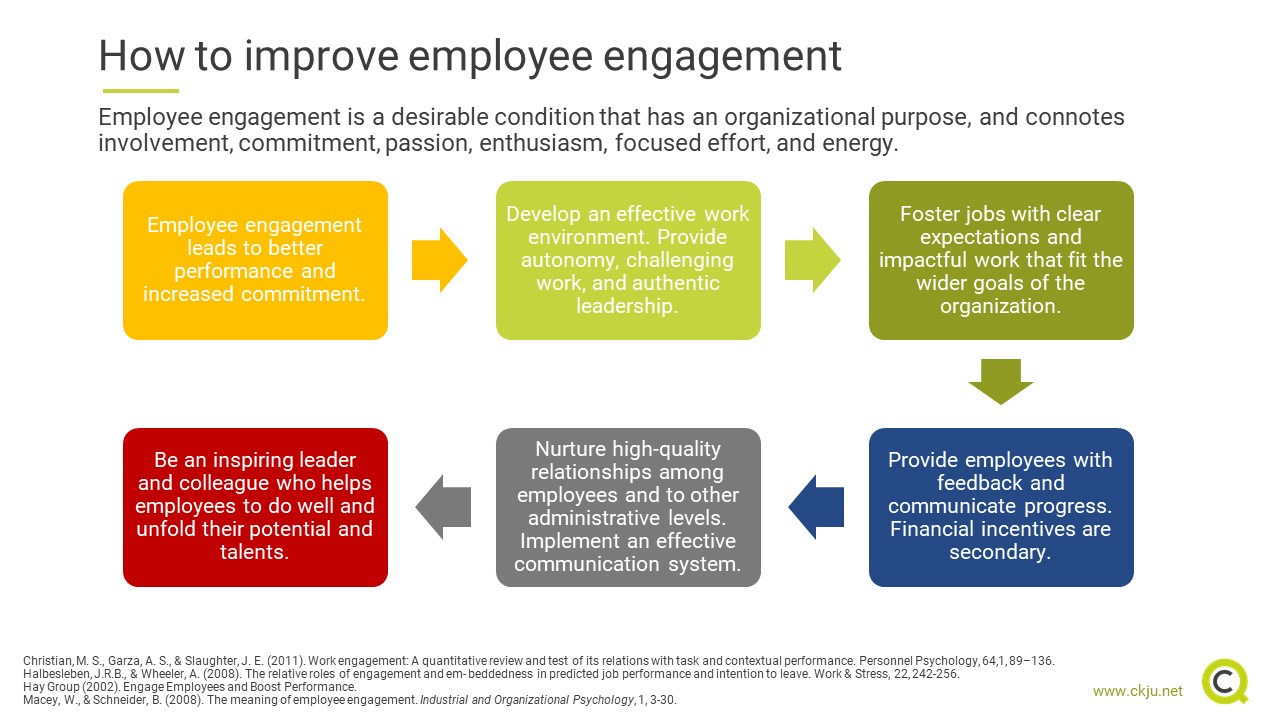- All Management Learning Resources
- Employee engagement

Executive summary
In this CQ Dossier we provide information on how to increase employee engagement. First, we define employee engagement and its components dedication, vigor, and absorption. Then, we have a look at the benefits of highly engaged people and provide recommendations on how you can implement strategies to increase employee engagement in your organization.
Contents
- Executive summary
- Employee engagement is a source of organizational performance
- What is employee engagement?
- Employee engagement can be experienced in three different ways
- How to improve employee engagement: Human Resource Management (HRM) practices
- What are the benefits of employee engagement? Performance and commitment
- How to measure employee engagement? The Utrecht Work Engagement Scale (UWES)
- How to improve employee engagement
- Key take-aways
- References and further reading
Employee engagement is a source of organizational performance
In today’s fast-paced economy, it is important that organizations implement practices and policies that encourage employee engagement. Without employee engagement, organizations are unable to attain business strategy objectives that will improve organizational performance (Seijets & Crim, 2006). Therefore, employee engagement is an integral source of financial and organizational performance (Macey & Schneider, 2008).
To be competitive, it is important that organizations and employees understand the nature of employee engagement and implement strategies that enhance engagement. In this CQ Dossier, we describe employee engagement and suggest strategies to enhance employee engagement.
What is employee engagement?
There are several definitions of employee engagement yet one that captures all the elements of the term is: employee engagement is a desirable condition, has an organizational purpose, and connotes involvement, commitment, passion, enthusiasm, focused effort, and energy (Macey & Schneider, 2008, p4). There are three components of employee engagement: dedication, vigor, and absorption (Schaufeli & Baker, 2004).
Dedication
When employees demonstrate dedication, they are enthusiastic and feel pride for their work. Dedicated employees feel that the work they are in charge of is significant and contributes to the overall objective of the organization. According to Schaufeli & Baker (2004), the opposite of dedication is cynicism.
Vigor
When demonstrating vigor, employees are invested in their work, and persist despite challenges they might face. They show a high level of energy and go the extra mile when necessary. Exhaustion is the oposition state of mind of vigor (Schaufeli & Baker, 2004).
Absorption
Absorption occurs when employees are very engrossed in their work. The concept of "flow" which describes a positive state where people are immersed in their work is closely related to absorption.
Employee engagement can be experienced in three different ways
Employee engagement is related yet is distinct from employee attitudes like job satisfaction and individual/organizational commitment. All these factors are important in creating a positive organizational climate and can be catalysts for organizational performance in a variety of ways (Macey & Schneider, 2008). Moreover, employees tend to experience engagement in a variety of ways.
- Trait engagement is the extent to which employees have a general positive attitude towards work. These employees tend to be happy and productive across a wide range of settings and jobs.
- State engagement is the extent to which employees feel engaged on a day-to-day basis so is a behavior rather than a trait.
- Behavioral engagement is shown through behaviors that go “above-and-beyond” typical job or taks performance, such as personal initiative, organizational citizenship behaviors etc.
Because state engagement is a malleable state and behavioral engagement arises through empowerment, this gives managers the opportunity to implement practices and policies that engage and motivate employees.
Management skills newsletter
Join our monthly newsletter to receive management tips, tricks and insights directly into your inbox!
How to improve employee engagement: Human Resource Management (HRM) practices
HRM practices can foster employee engagement through development of an effective work environment. In fact, there are certain aspect of the work environment that foster engagement.
Autonomy and variety can foster employee engagement and so the HRM function within the firm can design job positions that provide high levels of autonomy and variety (Christian, Garza, & Slaughter, 2011). Challenging work is also a motivator for employees because individuals thrive when they are dealing with difficult yet manageable work. Challenge can also lead to employee engagement (Crawford, LePine, & Rich, 2010). Managers can also have an impact on the work environment through their practices and behaviors. One way in which managers can engage their employees is through being fair and ethical in their dealings with subordinates. This type of leadership is more likely to lead to employee engagement (Saks, 2006).
What are the benefits of employee engagement? Performance and commitment
Employee engagement matters in workplace settings because when employees are engaged they are more likely to be effective performers. There is a plethora of research to support this hypothesis. When employees are engaged, they are more likely to perform better (Halbesleben & Wheeler, 2008). They are also more likely to be good organizational citizens and show commitment to the organization so they are less likely to leave (Saks, 2006). There is also research to show that in service environments employee engagement impacts customer satisfaction because employees are more likely to treat customers more fairly when they are engaged in their work (Sherwood, 2013).
How to measure employee engagement? The Utrecht Work Engagement Scale (UWES)
There are several ways in which to measure employee engagement. One of the most popular measures is the nine-item Utrecht Work Engagement Scale (Seppälä et al., 2008). This measure focuses on employee energy, dedication, and absorption. It is easy to administer and specifically focuses on employee engagement rather than on employee perceptions of the work environment. There is also a version of the UWES with 17 items which is available for free for scientific purposes.
How to improve employee engagement
Based on scientific research, there are several ways in which organizations can foster employee engagement.
First, employee attitudes towards their job and the organization matter (Crim & Seijts, 2006). Managers can show employees how their particular job fits into the wider goals of the organization and this can lead to effective customer service (Hay Group).
Provide clear job expectations
Managers should also provide employees with clear job expectations. If employees are not clear about the details of the job, then they are likely to become frustrated (Hay Group). When there is a climate of employee engagement, employees are more likely to be proactive in providing the organization with new ideas, when this innovation is linked to financial incentives such as commission or bonuses (Hulme, 2006). However, financial incentives are not enough.
Encourage regular feedback
It is also important that managers provide employees with feedback and communicate with their employees on their progress. Many times, employees want to hear that they have done a good job rather than just being handed a financial incentive. Organizations that are successful provide their employees with feedback (Lofthouse; Hay Group).
Foster high quality work relationships
Employees with high levels of engagement also enjoy high quality working relationships with peers, superiors, and subordinates. It is important that managers foster high quality relationships with their staff because the relationship between the supervisor and subordinate is particularly important for creating a high-quality climate (Ryan & Deci, 2000).
Ensure inspirational leadership
It is also important that employees respect and value the core principles of the organization. Employees are highly engaged when they are inspired by the leaders within the organization. When there is a lack of inspirational leadership, employees will not be engaged. Leadership approaches such as transformational and charismatic leadership have a strong focus on employee inspiration.
Implement an effective communication system
Finally, organizations can foster high employee engagement through implementing an effective communication system within the organization. This will provide employees with a clear and transparent picture of events within the firm (Harter, Schmidt & Keyes, 2003).
In conclusion, employee engagement is essential for organizations to be successful. There are several ways in which organizations can engage employees through creating jobs that provide autonomy and variety. Moreover, it is important that organizations implement strategies such as effective leadership programs so that managers are able to create interventions that engage their subordinates.
Key take-aways
- Organizations that actively engage employees are more successful
- The three components of employee engagement are dedication, vigor, and absorption
- When employees are engaged, they are more likely to perform better, be good organization citizens, and show commitment to the firm
- To increase employee engagement, it is important that leaders inspire their employees to do well
References and further reading
Cartwright, S., & Holmes, N. (2006). The meaning of work: The challenge of regaining employee engagement and reducing cynicism. Human Resource Management Review, 16, 199-208.
Christian, M. S., Garza, A. S., & Slaughter, J. E. (2011). Work engagement: A quantitative review and test of its relations with task and contextual performance. Personnel Psychology, 64,1, 89–136.
Crawford, E. R., LePine, J. A., & Rich, B. L. (2010). Linking job demands and resources to employee engagement and burnout: A theoretical extension and meta-analytic test. Journal of Applied Psychology, 95, 834-848.
Crim, D., & Seijts, G. H (2006). What Engages Employees the Most. Ivey Business Journal.
Halbesleben, J.R.B., & Wheeler, A. (2008). The relative roles of engagement and em- beddedness in predicted job performance and intention to leave. Work & Stress, 22, 242-256.
Harter, J., Schmidt, F., & Hayes, T. (2002). Business-unit level relationship between employee satisfaction, employee engagement, and business outcomes: A meta- analysis. Journal of Applied Psychology, 87, 268-279.
Harter, J. K., Schmidt, F.L. & Keyes, C. L. M (2003). Well-being in the workplace and its relationships to business outcomes. Flourishing: The positive Person and the Good Life, 205-244. http://media.gallup.com/DOCUMENTS/whitePaper--Well-BeingInTheWorkplace.pdf
Hay Group (2002). Engage Employees and Boost Performance. https://web.archive.org/web/20061123123100/http://haygroup.ca/pdf/knowle...
Hulme, V. A. (March 2006). "What Distinguishes the Best from the Rest". China Business Review.
Lofthouse, C. Building a thank you culture at work. Reward Gateway. https://www.rewardgateway.com/blog/building-thank-culture-work-reward-ga...
Macey, W., & Schneider, B. (2008). The meaning of employee engagement. Industrial and Organizational Psychology, 1, 3-30.
Ryan, R. M.& Deci, E. L (January 2000). "Self-Determination Theory and Facilitation of Intrinsic Motivation, Social Development, and Well-Being" (PDF). American Psychologist. 55: 68–78.
Saks, A. (2006). Antecedents and consequences of employee engagement. Journal of Managerial Psychology, 21, 600-619.
Schaufeli, W., & Bakker, A. (2004). Job demands, job resources, and their relationship with burnout and engagement: A multi-sample study. Journal of Organizational Behavior, 25, 293-315.
Seijts, G., & Crim, D. (2006). What engages employees the most, or the ten C’s of employee engagement. Ivey Business Journal, 70, 1-5.
Seppälä, P., Mauno, S., Feldt, T., Hakanen, J., Kinnunen, U., Tolvanen, A., & Schaufeli, W. (2008). The construct validity of the Utrecht Work Engagement Scale: Multi-sample and longitudinal evidence. Journal of Happiness Studies, 10(4), 459– 481.
About the Author

Related Dossiers





